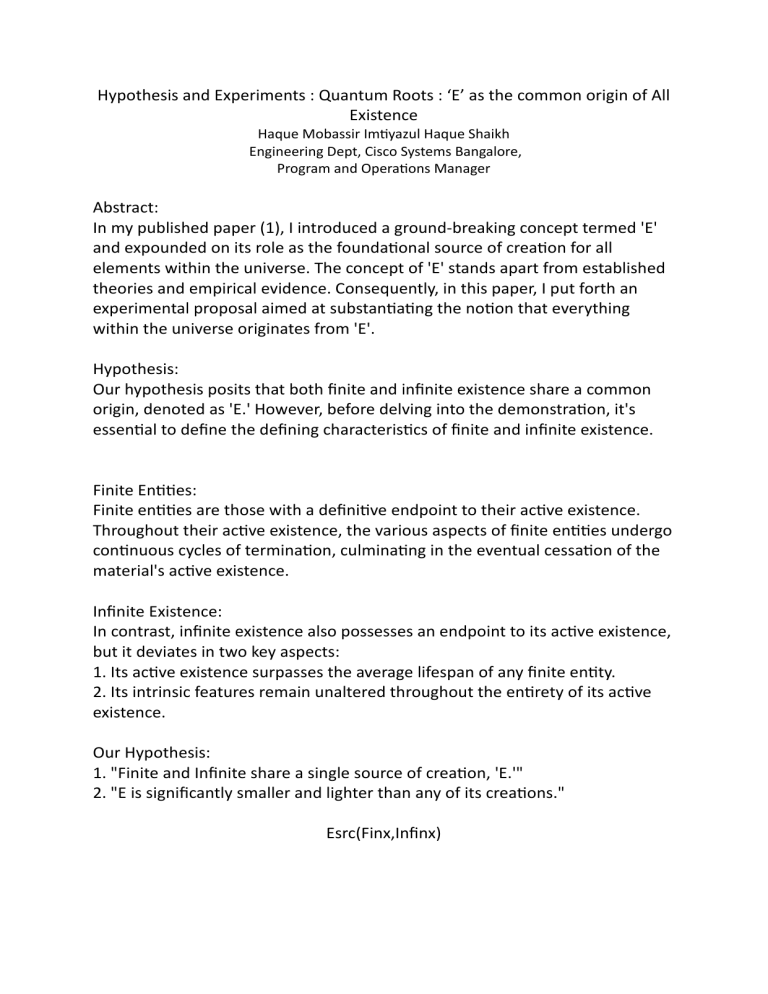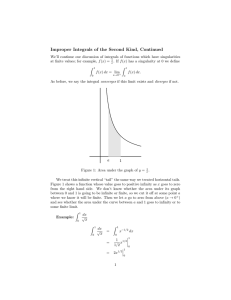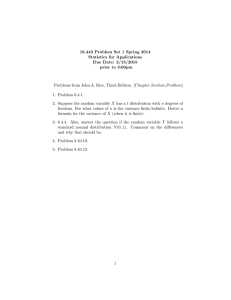
Hypothesis and Experiments : Quantum Roots : ‘E’ as the common origin of All Existence Haque Mobassir Im/yazul Haque Shaikh Engineering Dept, Cisco Systems Bangalore, Program and Opera/ons Manager Abstract: In my published paper (1), I introduced a ground-breaking concept termed 'E' and expounded on its role as the foundaFonal source of creaFon for all elements within the universe. The concept of 'E' stands apart from established theories and empirical evidence. Consequently, in this paper, I put forth an experimental proposal aimed at substanFaFng the noFon that everything within the universe originates from 'E'. Hypothesis: Our hypothesis posits that both finite and infinite existence share a common origin, denoted as 'E.' However, before delving into the demonstraFon, it's essenFal to define the defining characterisFcs of finite and infinite existence. Finite EnFFes: Finite enFFes are those with a definiFve endpoint to their acFve existence. Throughout their acFve existence, the various aspects of finite enFFes undergo conFnuous cycles of terminaFon, culminaFng in the eventual cessaFon of the material's acFve existence. Infinite Existence: In contrast, infinite existence also possesses an endpoint to its acFve existence, but it deviates in two key aspects: 1. Its acFve existence surpasses the average lifespan of any finite enFty. 2. Its intrinsic features remain unaltered throughout the enFrety of its acFve existence. Our Hypothesis: 1. "Finite and Infinite share a single source of creaFon, 'E.'" 2. "E is significantly smaller and lighter than any of its creaFons." Esrc(Finx,Infinx) Given that all forms of existence possess mass, it follows that 'Esrc' must also have mass. However, its mass cannot be equivalent to that of finite or infinite existence, as both finite and infinite enFFes undergo mass changes aSer their creaFon. Mass =/ (Finxm + Infinxm) This elucidates our first hypothesis, explaining why 'E' is incredibly small and lightweight while sFll being the force that held every atom in the universe together before their separaFon. Now to Prove second point of the hypothesis where we saying that both finite and infinite have the existence To demonstrate the coexistence of finite and infinite existence, consider two atoms of different elements, labelled as 'x1' and 'x2.' Place these atoms within a confined space envelope and gradually reduce the envelope's dimensions unFl the atoms have no room for mobility. Now, leave this envelope untouched in an accelerated Fme speed arrangement, where effect of spending one day should be equal to 100 years. ASer around 27 years, which in accelerated Fme speed setup would be near to 1 million year, aSer which slightly increase the envelope dimension and you will see separaFon, that's formaFon of another atom. 'xn' is new created atom which is finite, while the factors responsible for its creaFon are infinite. These factors conFnuously influence 'x1' and 'x2,' and they will persist in doing so. This experiment substanFates the existence of both finite and infinite enFFes, emanaFng from a single source, 'E,' and clarifies why 'E' is incredibly small and lightweight. Conclusion: This experiment affirms the shared source of finite and infinite existence in 'E' and sheds light on why 'E' possesses an extraordinarily diminuFve and lightweight nature. References: 1) "The Essence of 'E': Unveiling the Infinitely Infinite" - Haque Mobassir ImFyazul Haque Shaikh - IJFMR Volume 5, Issue 5, September-October 2023. DOI 10.36948/ijfmr.2023.v05i05.7494.




